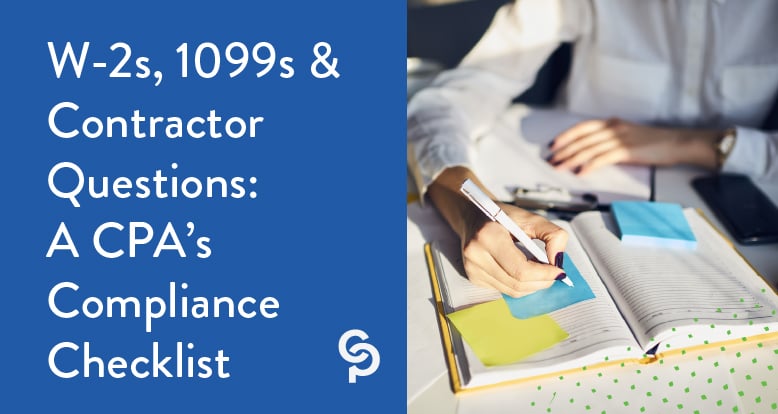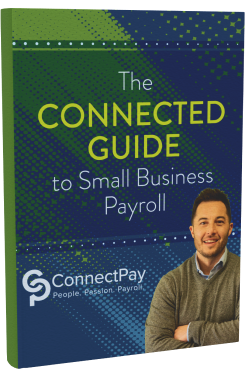W-2s, 1099s & Contractor Questions: A CPA’s Compliance Checklist

Business owners face the same pressures every January: making sure employee and contractor paperwork is filed accurately and on time or risk potentially costly penalties. The IRS expects workers to be correctly classified, the right forms issued, and deadlines to be met.
For CPAs, year-end payroll is about ensuring clients stay compliant and avoid costly mistakes. Here’s a compliance checklist to use as a guide while helping your business clients navigate the upcoming W-2 and 1099 reporting season.
Confirm Worker Classification Early
The IRS takes worker classification seriously, and missteps can mean big fines. Before you even think about W-2s or 1099s, confirm which workers are employees and which are independent contractors.
Key factors to review:
- Behavioral control: Does the business direct how the work is done or just the outcome?
- Financial control: Who covers expenses, supplies, and tools?
- Relationship terms: Is there an ongoing relationship, or is it project-based?
Payroll Tip: If you’re unsure, file Form SS-8 with the IRS to get an official determination. This can help protect against penalties later.
W-2 Checklist for Employees
- Verify employee information
- Match names and Social Security numbers to Social Security Administration records.
- Watch for name changes after marriage or divorce.
- Check payroll records
- Confirm all wages, tips, and bonuses are included.
- Verify benefit contributions (401(k), health insurance, etc.).
- Double-check IRS guidance (to be published in early fall) on how to report income tax-exempt tips and overtime. (The IRS has already announced that there will be no changes to 2025 Form W-2s and 1099s.)
- File & distribute on time
- Distribute W-2s to employees by January 31.
- File with the Social Security Administration by January 31, using Form W-3 as the transmittal.
Potential Penalties: Late filing or incorrect information can cost up to $340 per form.
1099-NEC Checklist for Contractors
Independent contractors get Form 1099-NEC if they were paid $600 or more during the year for services. This is not for wages, but for payments to non-employees. (NOTE: The One Big Beautiful Bill changes this $600 threshold to $2,000 starting in 2026.)
- Gather W-9 forms
- Every contractor should provide a signed Form W-9 with their name, business name (if applicable), address, and Taxpayer Identification Number (TIN).
- Every contractor should provide a signed Form W-9 with their name, business name (if applicable), address, and Taxpayer Identification Number (TIN).
- Track payments
- Include checks, direct deposits, and electronic payments, except those processed by credit card (these are reported separately on Form 1099-K by the payment processor).
- Include checks, direct deposits, and electronic payments, except those processed by credit card (these are reported separately on Form 1099-K by the payment processor).
- Issue and file on time
- Send 1099-NEC to contractors by Jan. 31.
- File with the IRS by Jan. 31 (both paper and e-file).
Potential Penalties: Same penalty scale as W-2s. Errors or late filing can add up quickly.
Special Cases to Watch
Worker classification and reporting aren’t always cut-and-dry. CPAs should flag these common tricky situations:
- Single-member LLC contractors – Still require a 1099 unless they’re taxed as a corporation.
- Attorney payments – Always require a 1099, even if the law firm is incorporated.
- Rent payments – Commercial rents over $600 require a 1099-MISC.
- Prizes and awards – Nonemployee prizes over $600 also go on 1099-MISC.
Ongoing Best Practices for Compliance
Keeping clients compliant means building habits, not scrambling in January.
- Require W-9s before payment – Don’t cut the first check to a contractor until you have their tax info.
- Use accounting software tracking – Tag vendor payments as 1099-eligible during the year to simplify reporting.
- Review payroll quarterly – Prevents surprises like missing bonuses or fringe benefits at year-end.
- Double-check state rules – Some states have additional reporting requirements or separate deadlines.
A well-structured W-2 and 1099 process, combined with accurate worker classification, can prevent costly penalties and reduce the risk of IRS issues for you and your clients.






